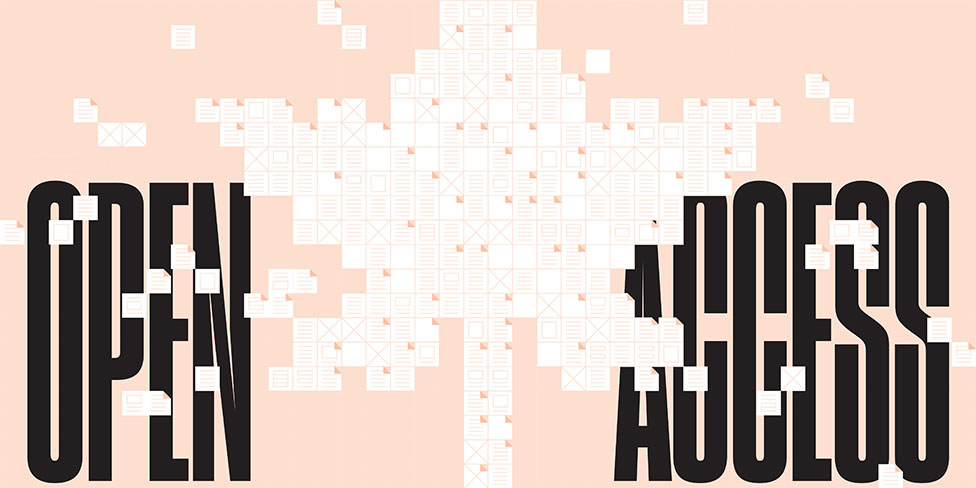Catching up on open access
A decade ago, Canada was at the forefront of open access publishing. Now critics say those policies are due for a drastic rewrite.

The days of the traditional, subscription-based scholarly journal seem to be numbered. Around the world, research funders are adopting ever-more expansive policies requiring the researchers they fund to make the results of their work freely accessible to the public. Canada, once a leader in this area, risks falling behind its peers unless it moves to keep pace with the latest developments.
Canada’s three federal research-funding agencies – the Natural Sciences and Engineering Research Council (NSERC), the Social Sciences and Humanities Research Council (SSHRC) and the Canadian Institutes of Health Research (CIHR) – adopted a joint open access policy in 2015. The policy requires grant recipients to ensure that any peer-reviewed journal publications arising from Tri-Agency funding are made publicly available to read for free within 12 months of publishing. Researchers may opt to make their published research accessible either through an online repository (essentially a free digital archive hosted by an institution or an organization) or by publishing in a journal that offers content without a direct cost to readers. But the landscape of scholarly publishing has evolved significantly in the eight years since the Tri-Agency decision, and the open science movement has gained steam. Now, many in the scientific community say Canada’s open access policies are due for a rewrite.
“The policy was ahead of its time in 2015, but now it’s a bit dated,” says Michael Donaldson, director of strategic initiatives at Canadian Science Publishing. “They need to start thinking about a new policy that is more in line with some of the international policies that have come out in the past few years.”
Other funders are moving away from the 12-month publishing embargo. Last summer, the U.S. Office of Science and Technology Policy issued a memo that directed federal departments and agencies to update their public access policies by the end of 2025 to make publications and research funded by taxpayers publicly accessible, without delay or cost. On a wider scale, a host of research funding agencies – including U.K. Research and Innovation and the Fonds de recherche du Québec (FRQ) – have signed up to Plan S, an ambitious open access publishing initiative requiring researchers to either publish in a journal that makes the version of record immediately open access, or to deposit the accepted manuscript in an open repository at the time of publication. Plan S also requires that research be published under a licence, such as Creative Commons, that allows users to share and adapt the article for any purpose.
Like Dr. Donaldson, Stefanie Haustein, co-director of the Scholarly Communications Lab at the University of Ottawa, believes the Tri-Agency’s 12-month embargo, which the scientific community saw as a good compromise at the time, is now outdated and should be dropped. The pandemic, for example, brought into sharp focus the importance of timely public access to scientific information. “The idea that science should be slowed down so that companies can make a profit has now shifted in people’s heads,” she says.
“The idea that science should be slowed down so that companies can make a profit has now shifted in people’s heads.”
And in any case, compliance with the Tri-Agency’s policy among Canadian researchers appears to be low. Leigh-Ann Butler, a master’s student in Dr. Haustein’s lab, looked at more than 250,000 papers by Canadian authors published between 2015 and 2018 and found that just 46 per cent were available in any form of open access. The numbers barely improved among roughly 100,000 papers that explicitly acknowledged Tri-Agency funding: just 48 per cent were published open access, indicating that more than half did not follow the policy.
There were some stark differences in the rate of compliance between the three agencies. Almost 65 per cent of papers funded by CIHR were published open access, compared with 44 per cent for NSERC, and 30 per cent for SSHRC. Ms. Butler says a lot of that disparity is down to the culture and history of different scientific communities and their specific publishing practices over the years. “Fields differ a lot in their culture and uptake of open access,” she says. “It impacts each agency’s researchers in a different way.”
CIHR, for example, has had an open access policy in place since 2008, so medical researchers have had longer to get used to the idea. NSERC supports researchers in fields where proprietary rights and intellectual property rights are often of great concern. Meanwhile, scholars in the social sciences and humanities face different publication trends in areas of research that tend to prefer books and monographs as primary outlets for their work – though these formats, which generally have longer publication timelines than journals and research articles, are also navigating the switch to open access under an increasingly pressurized funding environment.
But other factors are also driving this low rate of compliance with the Tri-Agency policy. First, publishing in an open access venue can be expensive. Most open access journals or publishers charge an author fee for publication so that readers can access the content for free, a version known as “gold OA”. Under this approach, it’s understood that authors also contribute monetarily to the overhead costs of publication. As an alternative, many traditional subscription journals offer to concurrently publish an open access version for a fee, a model known as “hybrid OA”. Those author fees, especially for high-profile subscription journals, can run to thousands of dollars per paper. “If you get a $20,000 grant, do you really want to spend $5,000 of that on open access [fees]?” says Ms. Butler, noting that the money could instead be used to hire a research assistant.
Author fees add up to huge amounts of public money going mainly to the big five academic publishers: Elsevier, Sage, Springer-Nature, Taylor & Francis, and Wiley, which Ms. Butler and Dr. Haustein call “the oligopoly.” Ms. Butler found that for the roughly 11,000 gold and hybrid papers published in oligopoly journals that acknowledged Tri-Agency funding during the four-year period she analyzed, researchers spent nearly $34.5 million (US$25.3 million) on article processing charges.
Of course, there is always the cheaper option of uploading papers to a public repository after 12 months or sooner, depending on the publishing agreement. This is known as “green OA”. Many Canadian universities offer this service to staff, but the process can involve complicated issues around copyright based on the version of the paper being uploaded, and researchers are given little support to ensure they are doing it right. Then there is the purely logistical challenge that comes with 12-month embargos, which leave it to a researcher to remember and then take the time to upload a paper to a repository, a full year after it was first published. “Who puts that in the calendar? You’ve already moved on,” says Dr. Haustein.
And with little in the way of tangible benefits for publishing open access – and no tangible consequences from funders for failing to – it is perhaps not surprising that many Canadian researchers appear to be ignoring the rules. “There’s no enforcement or monitoring,” says Ms. Butler. “You can make the choice to comply, but no one is checking.”
Kori St-Cyr, director of policy and government relations at NSERC, says the agency is keeping an eye on compliance with the open access policy and how it compares with other funders. About 74 per cent of U.S. federally funded research was published open access between 2017 and 2020, for example. In France, 67 per cent of research was published open access in 2022. But Mr. St-Cyr points out that statistical analyses of publications used to track researcher output and impact – a method known as bibliometrics – can be limited because not everyone remembers to acknowledge their funders.
Nevertheless, the agency is considering how to encourage greater compliance with the policy. “We’re looking at how this is implemented at other funders, what are the pros and cons, and best practices. We’re evaluating our options to identify things we could do,” Mr. St-Cyr says, though he would not identify any specific ideas being considered. Ms. Butler says having a dedicated repository, as the U.S. National Institutes of Health has with PubMed, or publicly tracking rates online, as with the French Open Science Monitor, can help boost compliance.
In the bigger picture, NSERC and the other Tri-Agency funders are also in the process of evaluating what might need to change in the policy, though again no specifics were offered. “We are still discussing our options,” says Mr. St-Cyr. “We’re fully aware of the shift in the ecosystem globally and are assessing what we can do to encourage the continued move to open access.”
Some parts of Canada’s funding ecosystem have already updated their open access policies to better reflect current publishing models. Starting with competitions launched in July 2022, FRQ now requires all researchers to provide an immediate open access copy of all peer-reviewed publications, either via an open access journal or repository, and to publish under specific forms of Creative Commons or equivalent licences.
In addition, FRQ funding can only be used to pay article processing charges if the journal is completely open access, or is a subscription-based journal that has signed a “transformative agreement”. Under the latter arrangement, libraries negotiate a fee that covers both subscription and article processing fees for authors associated with that library. Researchers may also opt for what FRQ deems a “transformative journal,” a publication that has demonstrated a commitment to fully transition to an open access model.
Emmanuelle Levesque, research ethics adviser at FRQ, says this means that some researchers may have to look for new journals to work with if their preferred publications do not meet the criteria. But that’s the point, she adds: “We have to push incentives for researchers to change their practice. They may not change by themselves if there is room in the policy [to avoid open access].”
“We have to push incentives for researchers to change their practice. They may not change by themselves if there is room in the policy [to avoid open access].”
Research conducted by many of the federal government’s own labs is now expected to be publicly available without delay. The standard was set out in the Roadmap for Open Science introduced by chief science adviser Mona Nemer in 2020, and follows the federal Treasury Board’s Directive on Open Government. Though not binding or enforceable, the Roadmap offers recommendations for how to make research and information widely available, with exceptions for privacy, confidentiality and security considerations. Dr. Nemer is now involved in consultations with the extramural research community to consider options on how to move to a harmonized regime. And she is optimistic that the Tri-Agencies will soon follow suit in dropping their embargo.
“Clearly our peer countries and those with whom we collaborate are moving in this direction, so it’s time for us to update our policies as well,” says Dr. Nemer. “At some point we just have to declare a date and work towards it.”
Many academic publishers are already making the shift to open access. Canadian Science Publishing currently has three open access journals – all launched within the past five or six years – and plans to transition the rest of its publications over the next five years or so, says Dr. Donaldson.
“We’re committed, but it’s a big shift, and risky from a business perspective,” he says. “The transition is our top priority, we want to get our journals built up to be as strong as they can be so the transition is successful.”
Susan Haigh, executive director of the Canadian Association of Research Libraries, says not-for-profit publishers, such as Canadian Science Publishing, are usually happy to move to open access as long as they can be sure of stable funding to cover their costs. Initiatives such as Coalition Publica, a partnership between Érudit and the Public Knowledgep Project which provides inexpensive digital infrastructure for scholarly publishing, can help by taking care of the back-end functions that account for the bulk of a journal’s costs.
Commercial publishers, on the other hand, have evolved their own ways of maintaining revenues while providing some form of open access. Transformative agreements are the latest manifestation of this. The big commercial publishers have been signing transformative agreements with libraries and library consortia around the world – the Canadian Research Knowledge Network, for one, has signed agreements with SAGE, Wiley and Cambridge University Press, among other publishers. The idea is that this will allow the publishers time to transition to au fully open access approach, but Dr. Haustein says she has yet to see any agreements with actual end dates for the subscription model. “It’s an arms race,” she says. “As we make better policies, the publishers still find ways to get their share.”
But researchers also have their concerns about open access, says Ms. Haigh. Most tenure and promotion criteria still rely heavily on publication records, for which high-impact journals, published by large commercial publishers, are the most valuable. “Researchers are hoping to see broader assessment criteria,” says Ms. Haigh. “We need to help them feel more comfortable publishing open access.”
That’s why Dr. Haustein thinks that top-down policies are the only way to make the shift to open access happen. “It has to be mandates and they have to be monitored,” she says.












Post a comment
University Affairs moderates all comments according to the following guidelines. If approved, comments generally appear within one business day. We may republish particularly insightful remarks in our print edition or elsewhere.
2 Comments
Interesting article, but how much is it going to cost public institutions (i.e., funding agencies and universities) for faculty to publish all of their outputs in open access journals? Will faculty have to start paying the fees if they don’t have funding for research (not all research requires extensive funding)? Implementation of requirements for all funding to require open access will mean that there are few alternatives to open-access publishing, so what does one do if they don’t have the funding to pay the high open-access fees?
Perhaps universities and faculty should consider self-publishing, with the opportunity for peer review after publication? Things are changing but are they going to change enough to fix the problems with peer review and inadequate funding?
Your statement that ‘Most open access journals or publishers charge an author fee’ is not true. 12,919 out of the 19,227 open access journals indexed in DOAJ don’t charge any fee at all. ‘Author fees add up to huge amounts of public money going mainly to the big five academic publishers’ because that’s where universities and authors choose to publish. Open access does not equal author charges.